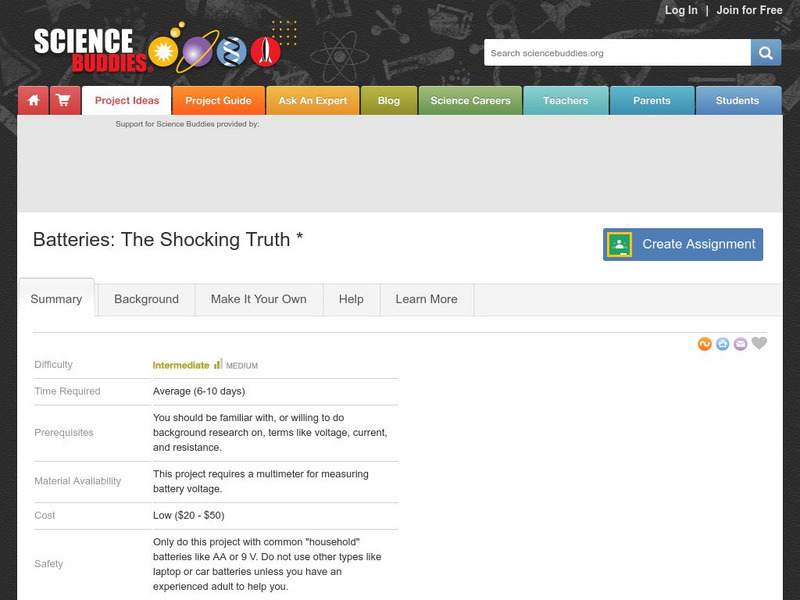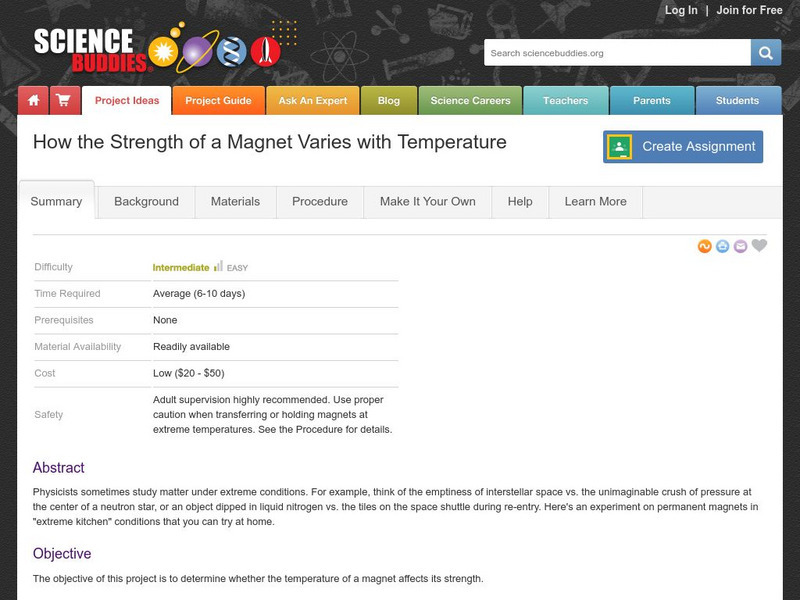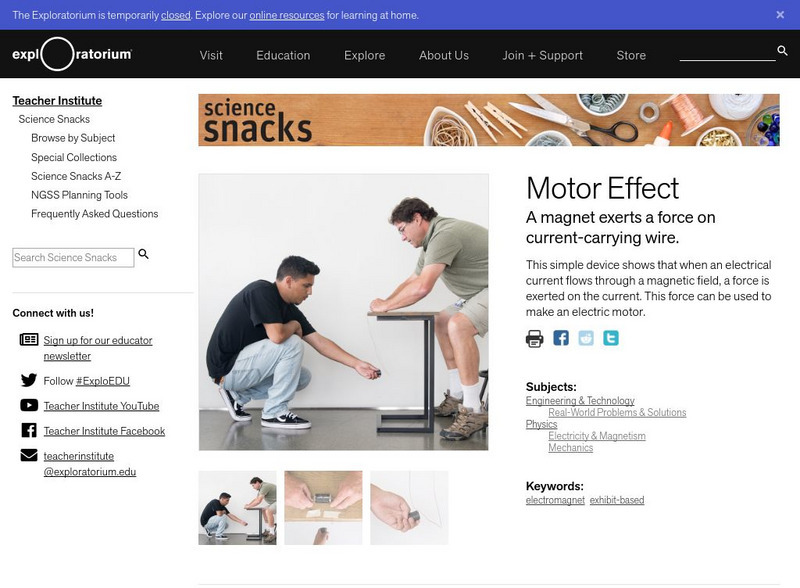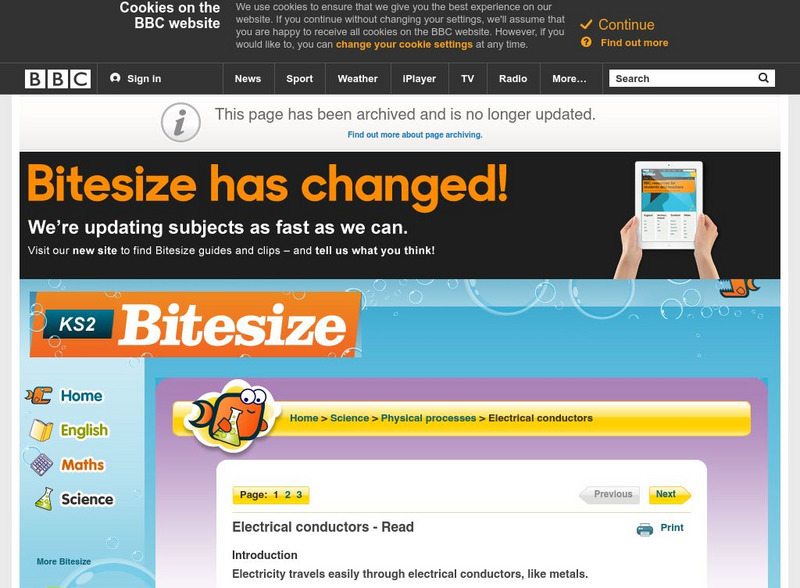University of Kentucky
Virtual Workshop: The Course on Electricity & Magnetism
On line course on Electricity and Magnetism for graduate credit or professional development, that emphasizes hands on activities you can use in your classroom.
CK-12 Foundation
Ck 12: Physical Science: Electromagnetic Induction
[Free Registration/Login may be required to access all resource tools.] Covers what electromagnetic induction is, how it occurs, the current produced from it, and how it is used.
Science Struck
Science Struck: Lcr Meter Working Principle and Uses
Explains what an LCR meter is and how it is used to measure the inductance, capacitance, and resistance of a circuit. Lists the different parameters of a circuit that it measures, describes two types of LCR meters, and gives definitions...
Science Buddies
Science Buddies: Batteries: The Shocking Truth
Here you can find what you need to scientifically assess battery performance. In this exercise (that should take about one week) learn how batteries work, how they wear out and most importantly, how to make valid measurements to assess...
Science Buddies
Science Buddies: How the Strength of a Magnet Varies With Temperature
Physicists sometimes study matter under extreme conditions. For example, think of the emptiness of interstellar space vs. the unimaginable crush of pressure at the center of a neutron star, or an object dipped in liquid nitrogen vs. the...
Science Struck
Science Struck: Difference Between Alternating and Direct Current
Explains what alternating current and direct current are and what they are used for.
Exploratorium
Exploratorium: Science Snacks: Magnetic Pendulums
See how electricity and magnetism interact with this activity. Activity has students creating a current by swinging a copper coil through a magnetic field. The copper coil will start a second coil swinging as well.
Exploratorium
Exploratorium: Science Snacks: Motor Effect
Create a simple device to see how a force is exerted on a current by a magnetic field. This activity shows how an electric motor can be made with this force.
Museum of Science
Museum of Science and Industry: Online Science: Make a Circuit Board
Step-by-step illustrated instructions showing how to build a circuit board using everyday materials.
Utah State Office of Education
Utah Science: The Mysterious Force
There is a secret mysterious force in your home right this very moment! Try these activities to first identify that force and then extend your knowledge of the force by investigating the other activities provided.
Hunkins Experiments
Hunkin's Experiments: Electric Shocks!!
Hunkin's Experiments is a group of simple cartoon illustrations of scientific principles. Some would work well in the classroom, but others have little value beyond entertaining students. All of the projects are easy to do. These...
Exploratorium
Exploratorium: Science Snacks: Modulated Coil
Can you hear a magnet? In this activity you will be able to transfer the sound from your iPhone, iPod or radio to a cassette-tape player.
Science Struck
Science Struck: Electromagnetic Energy and Why It Is Important
Explains what electromagnetic energy is, the history of its discovery, some terms used when talking about it, and gives some facts about it.
Khan Academy
Khan Academy: Application of the Fundamental Laws
We solve a circuit by direct application of the fundamental laws: Apply element laws (Ohm's Law and the like) plus Kirchhoff's Laws to solve for the currents and voltages of a circuit.
American Association of Physics Teachers
Com Padre Digital Library: Open Source Physics: Rail Gun Model
Simulate the movement of a rail gun in this interactive model. Learn how a magnetic field is generated by running electrical current through long rods that accelerates a current-carrying cross-rod.
Khan Academy
Khan Academy: Electric Potential Difference and Ohm's Law Review
Review the key terms, equations, and skills related to Ohm's law, including how electric potential difference, current, and resistance are related.
Khan Academy
Khan Academy: Dc Circuit and Electrical Power Review
Review the components of a circuit and their symbols such as battery, resistor, and switch. Analyze how the power of a resistor is related to the current and electric potential difference across the resistor.
National High Magnetic Field Laboratory
Magnet Academy: Timeline of Electricity and Magnetism: 1880 1889
Nikola Tesla and Thomas Edison duke it out over the best way to transmit electricity and Heinrich Hertz is the first person (unbeknownst to him) to broadcast and receive radio waves.
Creative Science Centre
Creative Science Centre: Kelvin Water Dropper Electrostatic Ht Generator
Lord Kelvin (William Thomson) developed electrostatic theory and a range of novel and interesting electrostatic apparatuses. Described here is a reconstruction of a water dropper electrostatic generator. It's capable of generating...
BBC
Bb Ci Schools: Revisewise Science Electricity
This lesson provides an interactive activity on electrical circuits along with a information sheet and a practice test.
BBC
Bbc Schools: Ks2 Bitesize: Science: Physical Processes: Electrical Conductors
A review of electrical conductors and insulators, with diagrams, activities, and quiz questions.
E-learning for Kids
E Learning for Kids: Science: Arctic Ocean: What Are Conductors and Insulators?
Visit Vlad and learn about the properties of conductors and insulators, and what materials are used for them.
Discovery Education
Discovery Education: Build Your Own Perpetual Motion Machine [Pdf]
A lesson plan for students to explore the conversion of energy from electrical energy to kinetic energy by constructing a homopolar motor. Also by constructing the motor, students can investigate magnetism, electricity, and RPM.
CK-12 Foundation
Ck 12: Physical Science: Chemical and Solar Cells
[Free Registration/Login may be required to access all resource tools.] How chemical and solar cells work and produce an electric current.




















